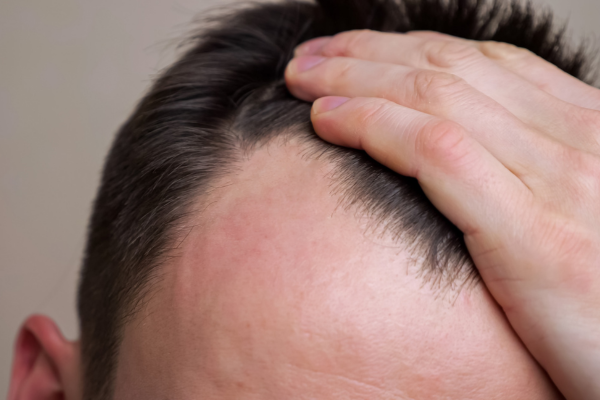
Androgenetic alopecia, commonly referred to as male pattern baldness or female pattern hair loss, is a genetic condition that affects around 50% of men and 40% of women by age 50. Some men may start to lose their hair in their teens or early 20s. Androgenetic alopecia is progressive and manifests differently in each gender.
In this article, we’ll cover:
- What Is the Difference Between Male and Female Androgenetic Alopecia?
- What causes androgenetic alopecia?
- What are the signs of androgenetic alopecia?
- How do you treat androgenetic alopecia?
- Can you get a hair transplant if you have androgenetic alopecia?
Male vs. Female Androgenetic Alopecia
Men and women with androgenetic alopecia display hair loss differently. In men, hair loss primarily occurs at the temples and the vertex (crown). As hair loss progresses, a receding hairline develops. The back and sides of the hair are usually unaffected.
In women, female-pattern hair loss is more widespread and starts with thinning around the part or crown, before progressing to visible hair loss across the scalp. Unlike with male-pattern baldness, the back and sides may be affected.
What Causes Androgenetic Alopecia?
Genetics and androgens, particularly dihydrotestosterone (DHT), a hormone produced from testosterone, are the culprits that contribute to androgenetic alopecia. These hormones activate androgen receptors in hair follicles, causing them to shrink and leading to gradual hair loss. Genetics also contribute significantly. If your parents or close relatives experienced hair loss, you’re more likely to be part of this club.
What Are the Signs of Androgenetic Alopecia?
Androgenetic alopecia typically appears with gradual hair thinning and loss. As noted above, it often begins with a receding hairline at the temples, followed by thinning at the crown in men. Then, it eventually leads to partial or complete baldness. Women may experience a widening part and overall thinning of the hair. Both men and women may notice increased hair shedding, especially during washing or brushing. You may often notice miniaturization of hair follicles, resulting in finer and shorter hairs.
How Do You Treat Androgenetic Alopecia?
While there is no cure for androgenetic alopecia, there are many treatments available to slow and sometimes reverse the progress of the condition. Treatment options range from prescription medication to PRP therapy to hair transplants.
Prescription Medications
Two FDA-approved drugs, Finasteride and Minoxidil, are used to treat androgenetic alopecia. Finasteride blocks the conversion of testosterone to DHT, while Minoxidil improves circulation and blood flow to hair follicles. These drugs have been proven effective in slowing down or stopping hair loss.
Platelet Rich Plasma (PRP) Therapy
Platelet-rich plasma is a revolutionary, clinically backed treatment proven to slow hair loss. PRP uses a concentration of platelets in your blood that contains regenerative growth factors. When used for hair loss, PRP releases these growth factors into the scalp to stimulate natural hair growth and increase tissue repair to weak or damaged hair follicles. Numerous studies have shown that PRP treatment reduces hair loss, thickens hair, and increases hair density.
At Lumen, we produce high-quality PRP using the Magellan TruPRPTM system. This innovative and advanced technology allows us to distill the purest and most concentrated PRP to maximize your results. PRP therapy can be performed as a standalone treatment, and it’s often recommended after a hair transplant to further support the follicles in their new location.
Hair Transplant Surgery
In many cases, a hair transplant may be an option, particularly for men, but sometimes women are candidates as well. Hair follicles from the sides or back of the head are harvested and then transplanted to the balding areas.

Before and after hair transplant surgery – view more images in the gallery
Scalp Micropigmentation (SMP)
Another increasingly popular option is scalp micropigmentation (SMP), which can be used in tandem with other hair restoration solutions or as a standalone treatment if a hair transplant is not an option. SMP helps camouflage hair loss and creates the appearance of more density. SMP involves injecting pigment into the skin using microneedles, creating small dots that mimic tiny hairs.
Can You Get a Hair Transplant if You Have Androgenetic Alopecia?
Yes, a hair transplant can be a viable option for many men with androgenetic alopecia who have a sufficient donor supply of viable hair follicles to transplant. Since female-pattern hair loss is usually more widespread across the scalp, affecting common donor areas, a small percentage of women are candidates for a hair transplant. However, many women have overcome hair loss and restored their confidence with Lumen’s 3-step hair program.
It’s important to remember that hair transplants are not created equal. There are two main types of hair transplant methods: Follicular Unit Extraction and Follicular Unit Transplantation.
FUE is far superior to the FUT method because this method produces natural-looking results that mimic the hairline. FUT usually refers to the strip harvest method, which removes a strip of skin and leaves a linear scar on the back of the head. The FUE method uses no scalpel incision or stitches, so there is no scarring, and recovery times are fast. Without a linear scar on the back of the head, you can wear even a short hairstyle. At Lumen, we only offer FUE hair transplants with the most advanced hair transplant technologies using the ARTAS iX® Robotic System and NeoGraft® Hair Transplantation System.
Hair Restoration Options for Androgenetic Alopecia
The good news is that there are many effective options for men and women with androgenetic alopecia. At The Lumen Center, we have a high rate of success and patients who have regained hope and their confidence. Founder Dr. Andrew Kwak and our expert team are ready to support you through the entire process — from diagnosis to treatment to aftercare.
Contact The Lumen Center in Bryn Mawr (just outside of Philadelphia) today to schedule your free consultation. We can help you find the most effective treatment program for your unique needs and goals in combatting androgenetic alopecia.
